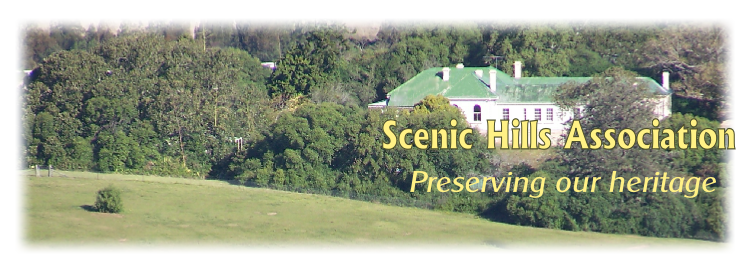
Varro Ville House and its surrounds
One of the historical treasures in our midst is Varro Ville House c.1859 overlooking the original Varro Ville estate. The house, designed by the former Colonial Architect William Weaver, occupies a narrow ridge (or saddle) on the south side of Bunbury Curran Hill, a landmark that led the original land grantee Dr. Robert Townson to refer to himself as being ‘of Bunbury Curran’. At the invitation of Dr. Townson, Governor and Mrs Macquarie climbed Bunbury Curran Hill in November 1810 to take advantage of views across the Cumberland Plain to Sydney. Macquarie wrote in his diaries “The accounts given to me by Mrs M. of the beautiful prospect she had from the top of Bunbury Curran Hill induced me to ascend it, which I did on horseback, and was highly gratified with the noble extensive view I had from the top of it of the surrounding country”.
Varro Ville, named by Dr. Townson after the Roman writer Marcus Terentius Varro (116-37 BC), is a celebrated early farm estate dating from pre-1810 with early structures, the 1850s homestead, layout, agricultural (… vineyard) terracing and evidence of early access road. It is rare as one of the few larger estate landscapes remaining in the Campbelltown area where the form of the original grant and the former agricultural use of the estate and its rural landscape character may be appreciated.
Varro Ville was significant to the horticultural development of New South Wales through the laying out of a productive kitchen garden in 1809 noted for its extensive fruit varieties by the early 1820s and the establishment of a vineyard, said to be second only to that of Gregory Blaxland of Brush Farm, Eastwood. The vineyard terraces are extant and together with the early drive suggest that the 1859 house may occupy the site of the earlier 1810s house.
It was also significant to agriculture and food production in early New South Wales. The grants of land at Minto were made by Colonel Paterson in response to the Hawkesbury floods of 1806 and later, aiming to safeguard the colony’s food supplies. A significant portion of Varroville was used for growing crops in the c. 1810s-1830s period. Townson supplied meat to the Sydney, Liverpool and Parramatta commissariat stores.
Macquarie commented that the farms of Townson and Andrew Thompson (St. Andrews, opposite Varroville) were ‘by far the best pasturage I have yet seen in the colony’. The gently rolling hills of the two properties appealed to English Picturesque sensibilities and today is reflected in the locality name, Scenic Hills, defined under the Campbelltown Local Environment Plan – District 8 Central Hills Lands. This plan aims ‘… to ensure that the Central Hills Lands District of the City of Campbelltown retains the rural character that was envisaged for it during the planning that preceded the urbanisation of that City.’
